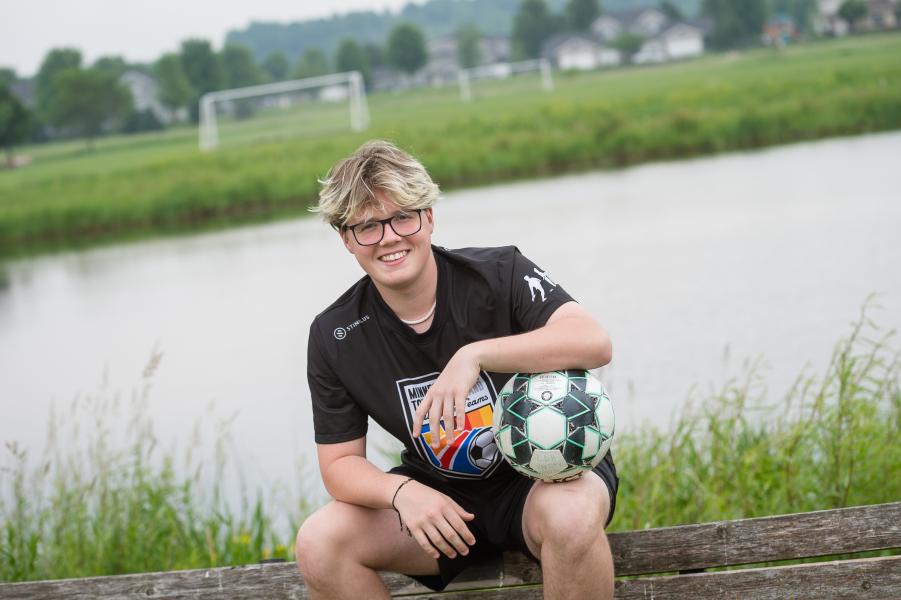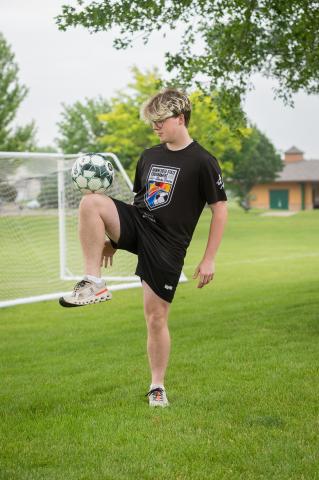Wyatt Norrie

Wyatt Norrie went into overtime.
Wyatt was playing indoor soccer when he pivoted hard while running and injured his left knee. “I didn’t think much of it,” Wyatt says. “I thought it was a sprain, and the doctor at the field agreed, so we ended up just getting a brace.”
Then three months later while walking in gym class, his knee “just went out.” Turns out he had torn his ACL and meniscus, two important structures in the knee that help stabilize the knee during cutting and pivoting actions, and that help cushion and distribute weight across the knee joint, respectively.
Wyatt was 12.
“That’s pretty young to end up with that kind of injury,” he says. “It was scary, especially since it would've been my first surgery.”
It’s a complicated surgery for an adolescent because of open growth plates. Growth plates are typically open as bones grow until around age 16-17 for boys and especially active during puberty; any damage could stall out growth in the leg and leave it shorter than the other leg. The new ACL graft must be cautiously potted in newly created bone sockets, without injuring or disturbing the growth plates. Orthopedic surgeon Hans Bengtson, MD was up to the challenge.
“My parents and I wanted to do the surgery with a person we trusted, and Dr. Bengtson did everything in his power to make sure me and my family were confident going through with the surgery,” Wyatt says. “Even if he was nervous, he never showed it. He was always comforting and well-spoken, so reassuring through the whole process.”
“It felt very safe and comfortable knowing we were in our home and being able to trust the person who was going to fix me.”
Surgery went well. Then it was time – a long time – to recover, with months of physical therapy. “I went through seventh and a bit of eighth grade with crutches and a brace,” Wyatt says. “It made me realize that even simple things such as being able to walk up a flight of stairs is not something to take for granted.”
Dr. Bengtson urged Wyatt not to rush back onto the soccer field. “He told me the chances of re-tearing the ACL or meniscus can be higher for multiple years. That happens most commonly before full PT recovery,” Wyatt explains. “I was so young and had a full sports career ahead of me and didn’t want to risk that.”
Wyatt spent 14 months on physical therapy and conditioning. “My recovery was expected to be 9 to 11 months, but I gave myself extra time to make sure I was 100%.”
That’s a long time for an athlete to sit out. “It was really hard to sit back and watch everyone play soccer while I had to stay home and continue my recovery,” Wyatt recalls. “It was difficult knowing I couldn’t do what I wanted to do so badly.”
But it was worth it: As an incoming freshman, Wyatt tried out for Northfield Raiders soccer and made the varsity team.

“I was sort of expecting to be rusty, but the recovery process plus weight training and individual workouts made me strong,” Wyatt smiles. “We went to state after winning our section that year.”
Wyatt also played in the Elite Clubs National League (ECNL), traveling the U.S. to compete. “It was pretty cool,” he says. “I give a lot of credit to the people involved in my recovery process in helping me have success in my athletic career.”
And now? “Other than the scars, I can barely tell I had the surgery.”
Wyatt’s advice for other young athletes: “Listen to your doctor. And stick with PT. Even though it might seem long in the moment and feel like it’s pointless, it’s the difference between coming back scared and unready, and coming back 100%.”
Because that’s the best way to score.
